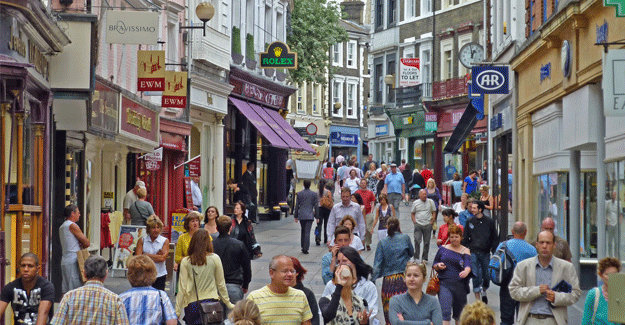UK Streets Ahead Of Major Economies
(Covering the four weeks 03 October – 30 October 2021)
2020 was a turbulent year in which much of retail bounced between being open and closed, impacting footfall significantly. The British Retail Consortium, in its latest analysis of retail, has compared 2021 figures with 2019 (pre-pandemic) figures for a more meaningful scenario.
According to BRC-Sensormatic IQ data:
- Total UK Footfall decreased by 13.7% in October (Yo2Y), with a 3.2 percentage point improvement from September. This is above the 3-month average decline of 16.0%.
- This was ahead of Spain (-19.8%), Germany (-26.1%), Italy (-34.6%) and France (-34.9%) in October (Yo2Y).
- In the UK, footfall on high streets declined by 18.3% in October (Yo2Y), 4.3 percentage points above last month's rate and above the 3-month average decline of 21.8%.
- Retail parks saw footfall decrease by 0.4% (Yo2Y), 1.2 percentage points above last month's rate and above the 3-month average decline of 1.4%.
- Shopping centre footfall declined by 33.6% (Yo2Y), 2.6 percentage points above last month's rate and above the 3-month average decline of 34.3%.
Northern Ireland saw the shallowest footfall decline of all regions at -10.8%, followed by Wales at -13.1% and England at -13.7%. For the third consecutive month, Scotland saw the deepest decline at -17.0%.
Helen Dickinson OBE, Chief-Executive of British Retail Consortium, said: “It was great to see the UK leading the way for footfall in October among the major European economies. This gives more retailers a reason to be hopeful as we enter the crucial golden quarter, with many embracing both digital and physical connections with their customers, and indicates that retail is playing a key part in the economic recovery. Footfall in retail parks almost reached its pre-pandemic level with their attractive offer of larger stores and free parking.
“While many UK cities have seen a significant rise in footfall in recent months, the largest cities – London, Birmingham and Glasgow – continue to lag behind other areas. Lower tourism levels, more working from home and lower usage of public transport due to Covid have disproportionately affected these cities as a result, as well as holding back shopping in city centres across the UK.”
Andy Sumpter, Retail Consultant EMEA for Sensormatic Solutions, commented: “October’s footfall bounced back after the September slowdown, as traffic was bolstered by half term and Halloween - now retail’s third-biggest trading event after Christmas and Easter. Halloween proved a welcomed excuse for seasonal socialising and helped consumer confidence around in-store shopping to remain un-spooked by the UK’s rising covid-19 infection rates.”
“Some of the lift in footfall performance, which saw retail parks in particular rise to their highest point of recovery since the start of the pandemic, may also be attributed to early Christmas spend, as retailers brought forward Christmas range launches to help smooth out supply chain bumps ahead of the peak trading period and consumers also indicated they would shop earlier for the festive season this year.”
Textile Excellence
Previous News
chile is learning to tackle its growing mountain of discarded clothes
Next News
how garment brands can tackle excessive overtime









